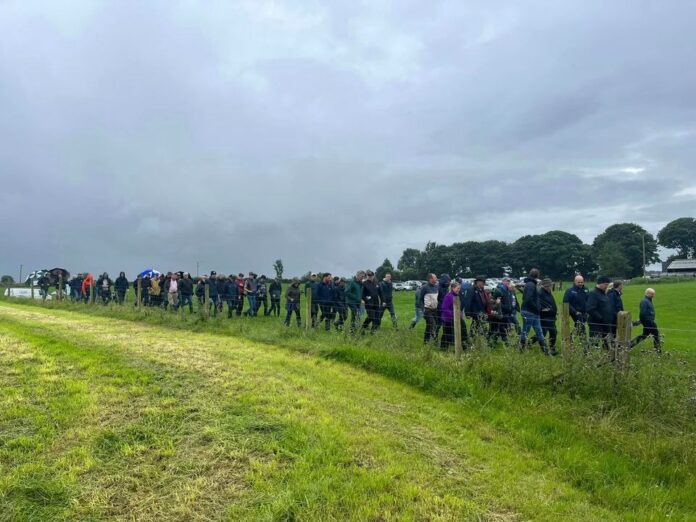That’s Farming visited the farm of Jarlath and Austin Ruane, in Corbally, outside Claremorris, Co Mayo, where they operate a dairy calf-to-beef and lowland sheep system.
In this article, we summarise some of the key take-home messages for farmers, shared by Jarlath at a DairyBeef 500 open day on the evening of Thursday, July 13th, 2023.
Calf sourcing policy
They believe in forging functional relationships with dairy farmers, knowing the history (health and nutrition – if they received adequate quantities of quality colostrum) and genetic make-up of the calf.
The Ruanes sourced 50 calves from 26 different sources (including dealers and marts) in 2019, 58 calves from 3 sources in 2020, 54 calves from 4 sources in 2021 and 78 calves from 5 sources in 2022.
Initially, a wide variety of sources brought about its own issues with an outbreak of scour and pneumonia occurring, which led to a changed calf sourcing policy. 2023 saw them acquire 79 calves from 4 farms in the vicinity, with the furthest source being 20 minutes away.
The father and son duo claim to have a 35% reduction in vet bills per livestock units over the period 2019-2023 since implementing the change.
Animal herd health plan
Their animal health plan, which they have compiled in conjunction with their local veterinary practitioner, revolves around the highest possible welfare standards, minimising any stressor factors where possible:
- Biosecurity – minimum source herds, quarantine protocols, hygiene;
- Vaccination policy – Pneumonia/clostridial/IBR;
- Parasite control – Faecal sampling, targeted treatments, management factors;
- Pneumonia prevention – reducing stress and creating the correct environment;
- Scour prevention – Good hygiene, correct nutrition (have automatic feeder since 2020, feed meal and fresh straw in early days for rumen development) and oral prevention.
As per their comprehensive animal health plan, upon arrival, calves are acclimatised and receive an intranasal vaccine to protect against RSV and Pi3, along with an oral drench against coccidiosis.
A turnout of calves receive a clostridial vaccine against blackleg, with a follow-on booster four weeks later.
Management – Providing the correct environment for calves
They focus on environments with adequate ventilation that is free-from draughts, dry with a good drainage system, the adequate use of straw (nesting scores – how well bedding is working to inflate calves against low temperatures, as explained in this news article), a fresh, clean water supply and regular cleaning and disinfection with hygiene being “number one”.
Mixed grazing
Their lowland flock of sheep graze behind calves early in the year, to reduce worm burdens. Working with their vet, they carry out regular faecal sampling during the year and follow targeted dosing protocol, as per professional veterinary advice, alternating between different classes of drugs to reduce resistance.
Paddocks’ potential
The Ruanes place an emphasis on maximising the use of grazed grass in animal diets through paddock systems, which is paramount since they bring steers through to slaughter from the calf stage.
The aim is to maintain grass of the highest quality in front of stock at all times to ensure optimum animal performance.
The benefits they see include increased grass production, better grass utilisation, enhanced animal performance and the production of better-quality silage, with an aim to reduce the age of slaughter and use less concentrates.
When establishing a paddock system, the aim should be, as per Teagasc’s advice, to grow grass in 3 weeks and graze in 3 days.
When planning a paddock system, it is important to map the farm, fence either permanently or temporarily, position water troughs correctly and have access points.
This particular farm benefits from an extensive network of roadways right along the paddocks and water troughs.
The Ruanes are attempting to increase the number of days animals spend at grass with a target of 250 days, with 229 days in 2022 and 211 days the previous year.
Average age of slaughter
Reducing the average age of slaughter has been one of their main focuses in recent times. Their targeted average age of slaughter is 24 months, and they came closest to this in 2022, at 24.2 months, compared to 25.5 months the year prior.
The bought-in dairy-bred calves are a mixture of Holstein Friesian, Angus, Hereford and Limousin and they are finished at various ages.
The heaviest of them are killed at 20-21 months of age, following the second grazing season, with the rest return to pasture for the third grazing season and being slaughtered at approximately 28 months.
Slaughter performance data in 2022:
- Steers – 19-21 months – x15 – 320kgs (average carcass weight)
- Steers 24 months – x37 – 339kgs;
- Steers under 30 months – x 16 – 344kgs.
On this enterprise, splitting slaughter dates “maximises the use of housing”, but their plan going forward is “to reduce the age of slaughter further”.
They plan to achieve this by reducing the number of cattle that have been turned back out for the third grazing season to under 10% of the total number of animals slaughtered on the farm.
Constructing a new slatted shed, under TAMS, and availing of the enhanced grant aid rate for young, trained farmers and registered farm partnerships is also another priority, attendees of the farm open day heard.
About the host farm:
The farm spans 34ha, which is predominately a clay-type soil, and is fragmented in nature, with four main blocks within a 5-mile radius of the home block.
Traditionally, the farm had a store-to-beef and lowland sheep enterprise and first dabbled in calf-to-beef in 2016 with the purchase of 10 dairy-bred calves.
Austin and Jarlath both work off-farm full-time and every year, rear approximately 80 calves, which arrive onto the west of Ireland-based enterprise, which has a stocking rate of 2.8LU/ha, from 2-3 weeks of age.
See more farming news on www.thatsfarming.com
Article on: ‘You should be giving less for the 1-star animal than the 5-star’





